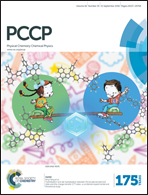The effect of the dopant nature on the reactivity, interlayer bonding and electronic properties of dual doped bilayer graphene
Abstract
Herein, we report on the structural, chemical reactivity and electronic properties of dual-doped bilayer graphene (DDBG). Only one of the layers was doped with a pair of 3p–2p elements. Aluminum was the only dopant which prefers to interact with the undoped layer. The interlayer interaction energies of DDBG are smaller than those determined for bilayer graphene, except for AlN and AlO DDBG. This effect is due to the presence of weak Al–C interlayer bonds. The dopants increase the reactivity of both the doped and undoped layers. Interestingly, we found that hydrogenation is a method that can be used to switch on/off the interlayer bonding, as it controlled the X–C interlayer distance (X = Al, Si, P, S). The magnetic moment of the systems can be adjusted by the position of the 3p dopant. In effect, when X interacts with the doped layer, the magnetic moment is reduced, while it is maintained when X fails to interact. Finally, we found that the doped layer is able to break the symmetry of the undoped sheet and small gaps can be opened in the band structure of the undoped layer. As observed for single doped monolayer graphene, the most effective element for such purposes is P, which opened gaps close to 0.2 eV. For SiN DDBG, the spin filtering properties are enhanced with respect to the monolayered structure.


 Please wait while we load your content...
Please wait while we load your content...